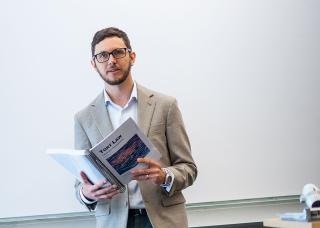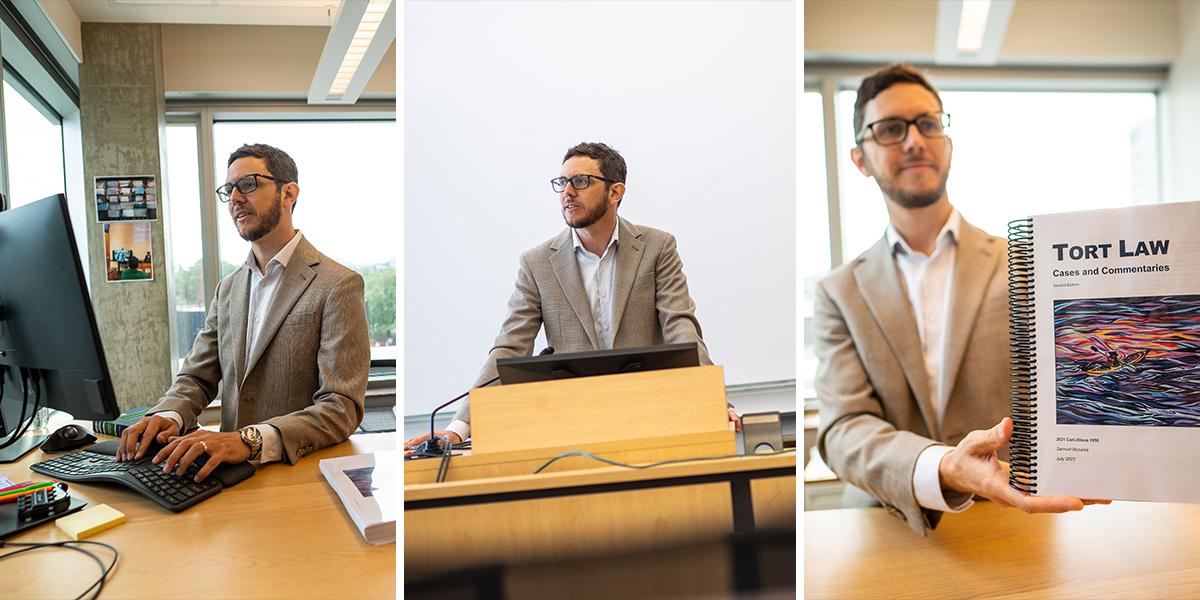Making the case for open-access law texts
Dr. Samuel Beswick has created Canada’s first online open-access tort law casebook

Dr. Samuel Beswick has created Canada’s first online open-access tort law casebook

In spring of 2022, we asked our teaching faculty to tell us who among them were offering innovative learning experiences, environments, and/or introducing new ways of overcoming barriers in their classes. This is part five in a six-part series recognizing teaching faculty at UBC.
In 2020, months into teaching tort law at the Peter A. Allard School of Law, Assistant Professor Samuel Beswick was struck by inspiration. With new judgments being decided every day and freely accessible online, he wanted to break away from the commercially published casebook model and bring the law to his students in an open educational medium.
So, with the help of his JD research assistant Maddison Zapach, Sam embarked on a project to create Canada’s first online open-access torts casebook—a format enabling him to innovate both in the selection of civil wrongdoing cases his class would study, and in the way students would access them.
“I wanted to customize my materials, and there were a couple of themes that I wanted to convey through the subject, such as the idea that we’re all supposed to be equal under the law,” Sam explains, noting that when he studied law in his home country of New Zealand, course readings were typically a set of photocopied or printed cases and articles assembled by the professor.
In North America, printed and bound casebooks are the standard which, says Sam, are not only cumbersome and costly for students but can be more limiting to teach from. “As a student, I was used to reading a ramshackle compilation of whatever a professor put together, and I quite liked that,” he shares. “An off-the-shelf copy has to be replaced with each new edition, and the copy is not easily customizable if you want to supplement or change up your own teaching.”
Rather than revert to spiral-bound printouts, however, Sam built an entirely new kind of casebook—one that is freely available to students and the public in online, PDF and ePub formats, and which is more interactive and flexible than printed materials alone. In the summer of 2021, he published the first edition of Tort Law: Cases and Commentaries on CanLII, available to anyone with an internet connection. All that’s required to update it is to edit a Word document and reupload it—which Sam has already done, publishing the second edition in the summer of 2022.
There’s more than just its format setting it apart from other casebooks. For one thing, it’s packed with edited cases from around the common law world, rather than only from Canada. “One of the unique things about Commonwealth common-law systems is that, when courts encounter new issues, it’s normal for judges to look to other jurisdictions to help them find the answers,” Sam notes. So, he pulled in cases from jurisdictions like India and Hong Kong, including some in which judges analyzed judgments from Canada to help them reach a resolution. “I thought it would just be really cool to show the students that that is part of the nature of common-law reasoning around the world,” he says.
Another differentiating factor is the way Sam included cases that demonstrate several different areas of the law. “There are some cases in the book that appear in up to seven different sections, dealing with different topics,” he says. “The traditional way is to introduce a new case for each topic. But I saw the students gain a more nuanced understanding of how judgments developed, because they got a much deeper understanding of the cases as they revisited them in different contexts.”
"I think there’s just huge potential for innovating university teaching resources.”
Dr. Samuel Beswick, Assistant Professor within the Peter A. Allard School of Law

Sam also supplemented the casebook with quizzes and exam exercises—along with links to podcasts, videos, blogs, news, articles and original judgment transcripts. As an indication of its scope, when printed in full, the first edition came in at a whopping 800 letter-sized pages. “I did send the PDF to the UBC Bookstore to be printed and spiral bound for students to buy at cost, and it was a bit of a mistake to print out the whole thing,” Sam admits, explaining that he encouraged his students to have a physical copy for use during exams. “This year, I’m not including the pages that I know I'm not going to teach, so it’s a much slimmer, and cheaper, volume.”
The response from his students has been overwhelmingly positive, who have given the resource top marks for usability and content. One typical response from an anonymous student survey reads: “I love the coursebook because it is inexpensive, and there are online and print versions. I also greatly appreciate the quizzes for exam prep.” More than one said it was their favourite textbook.
Dr. Beswick’s labour of love is also gaining fans from peers further afield. “I’ve heard from a few professors who have reached out and said they're planning to use it for their class next year, which is exciting for me, including one professor in Australia,” he says. All the positive feedback has encouraged him to take the project even further in its next iteration.
“My thought for the next edition is to expand the book quite considerably and make it a comparative tort casebook that can be taught in any common law jurisdiction, not just Canada,” he says. While the project has taken some work, it’s also one that he’s excited about sharing with the world. “I think there’s just huge potential for innovating university teaching resources,” he says.
Written by Jessica Werb, on behalf of UBC Internal Communications
September 2022
“My thought for the next edition is to expand the book quite considerably and make it a comparative tort casebook that can be taught in any common law jurisdiction, not just Canada.”
Dr. Samuel Beswick, Assistant Professor within the Peter A. Allard School of Law
Accounting. Marketing. Leadership. Lego? How UBC Sauder’s Dr. Kari Marken challenges her Creativity students with purposeful play (Sept. 20)
Science at the crossroads of creativity and ethics: Dr. Robin Young looks at cell biology through a lens of ethics, diversity and inclusion (Sept. 26)
Necessity is the mother of a delicious invention: Gerry Kasten and Joel Barohn are breaking down barriers and redefining how students learn to cook at UBC (Oct. 3)
A ‘quiet rumbling’ that led to a visible focus on student humanity: How Katie Lee Bunting’s shift towards values-based teaching transcends the confines of traditional thinking (Oct. 11)
Co-creating a future beyond the classroom: How Dr. Su-Jan Yeo emboldens students to turn urban planning ideas into real-world outcomes (Oct. 24)
Find the latest news, updates, events, and useful dates from across UBC, curated for faculty and staff by Internal Communications.
Access a library of resources from multiple UBC websites, all in one place.